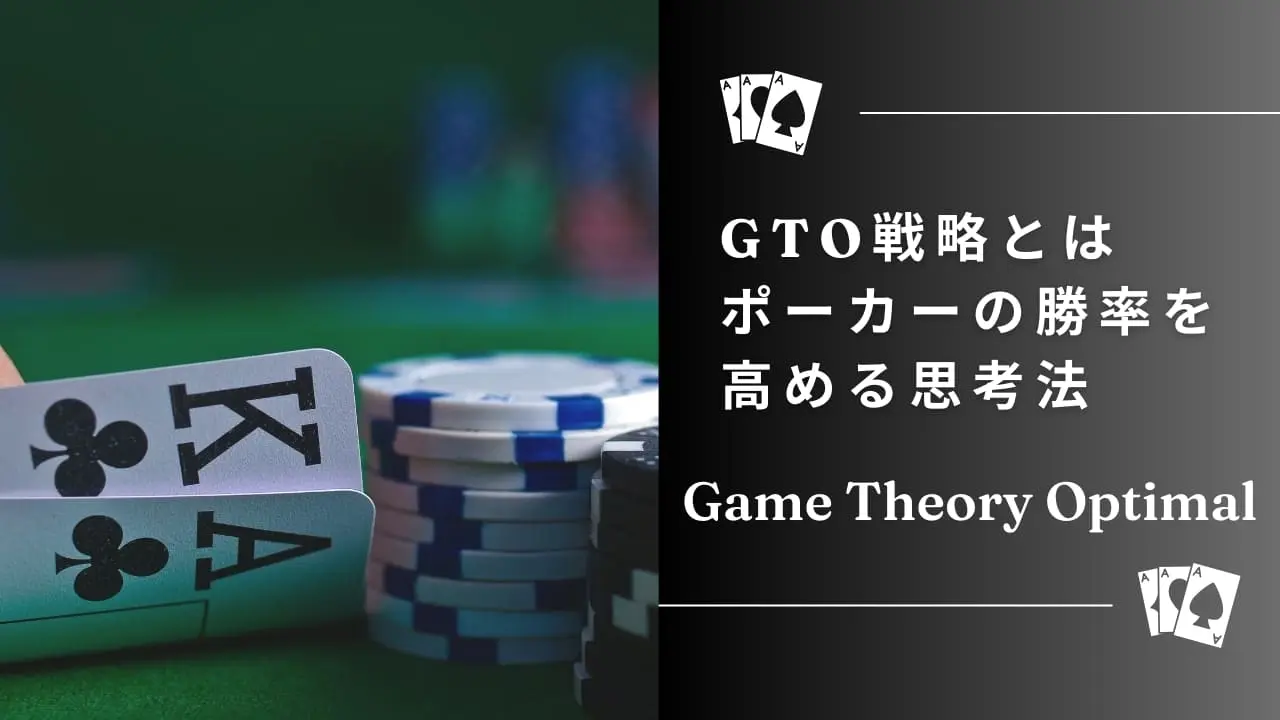In poker, there are two main types of strategies: exploitative strategy, where you analyze your opponent’s tendencies and capitalize on their weaknesses, and GTO strategy (Game Theory Optimal), which focuses on making decisions that cannot be exploited regardless of the opponent’s style.
By mastering GTO, you can protect yourself from being exploited and achieve consistent long-term profits. This article covers the fundamentals, practical methods, and advanced applications of GTO strategy in detail.
Understanding GTO Strategy
Definition of GTO
GTO, or Game Theory Optimal, is a mathematically sound strategy based on game theory. It is designed to make your play unexploitable by balancing your actions in a way that leaves no clear weaknesses for your opponent to attack.
Key principles include:
- ✔ Making unexploitable decisions based on logic and probability
- ✔ Balancing bluffing and value betting with optimal frequency
- ✔ Developing a strategy that performs well against any opponent
How GTO Differs from Other Strategies
Exploitative Strategy
An approach where you analyze your opponent’s habits and attack their weaknesses. While potentially more profitable against predictable players, it leaves you vulnerable to counter-exploitation.
Nash Equilibrium Strategy
A more rigorous version of GTO that assumes both players play perfectly. It’s highly theoretical and used in advanced modeling.
H4: Balanced Strategy
A hybrid between GTO and exploitative play, aiming to stay balanced while adjusting to opponents when necessary.
Mastering GTO allows you to play profitably against all types of players while minimizing the risk of being exploited.
Core Principles of GTO Strategy
H3: 1. Balance Bluffing and Value Betting
A fundamental element of GTO is keeping your betting ranges balanced. For example:
GTO Bluff Ratio on the River
If you’re betting a full pot, the optimal ratio is 2:1 value bets to bluffs.
That means for every 3 river bets, 2 should be for value and 1 should be a bluff.
Adjust based on your opponent:
- ✔ Bluff more if they fold too often
- ✔ Value bet more if they call too much
2. Build Optimal Hand Ranges by Position
Constructing proper hand ranges from each position is essential for a GTO approach.
Example – UTG (Under the Gun) GTO Opening Range
- Focus on premium hands like AA, KK, QQ, AKs, AQs
- Mix in suited connectors like 76s and 87s at low frequencies
Example – BTN (Button) Range
- Wider range, including many suited and offsuit hands due to position advantage
Tips:
- ✔ Know the optimal range for each position
- ✔ Adjust slightly depending on opponent tendencies
3. Optimize Your Bet Sizing
Bet sizing is a critical part of GTO strategy. The size you choose should reflect the board texture and the range you’re representing.
Common GTO Bet Sizes
- Flop: Smaller bets (e.g. 1/3 pot) are often optimal
- River: Larger bets (full pot or overbet) apply more pressure
Example – Bet Sizing by Board Type
- Dry board (A♠7♦2♣): 1/3 pot is typically effective
- Wet board (J♠10♠8♦): 2/3 pot or more can deny equity and apply pressure
Key concepts:
- ✔ Adjust bet sizing to board texture
- ✔ Respond to opponent reactions and adapt accordingly
How to Practice GTO Strategy
1. Use GTO Solvers for Study
To deeply understand GTO strategy, use solver tools that simulate optimal decision-making.
Popular GTO Solvers
- PioSolver – Advanced and customizable
- Simple GTO Trainer – Beginner-friendly
- GTO Wizard – Visually intuitive and easy to learn
Study Tips:
- ✔ Use solvers to learn the logic behind decisions
- ✔ Practice repeating solver decisions in real hands
2. Real-Life GTO Examples
Case 1 – River Bluff/Value Bet Ratio
Board: K♦ J♠ 7♣ 5♦ 2♠
When betting full pot on the river, use a 2:1 value-to-bluff ratio. Adjust this ratio based on how your opponent plays.
Case 2 – GTO vs. Exploitative Adjustments
- If your opponent is overly tight, increase your bluff frequency
- If your opponent calls too much, increase value betting frequency
Takeaways:
- ✔ Start with a GTO baseline
- ✔ Adjust based on opponent behavior
- ✔ Exploit if you identify clear patterns
Conclusion – Mastering GTO for Long-Term Success
By mastering GTO strategy, you equip yourself with a powerful, unexploitable approach that works against all opponents.
Key takeaways:
- Balance bluffs and value bets
- Build position-specific ranges
- Optimize bet sizes based on board texture
- Use solvers to deepen your understanding
- Combine GTO and exploitative tactics for maximum edge
Understanding and applying GTO will significantly elevate your poker game. Use these principles to take your skills — and your winnings — to the next level.


